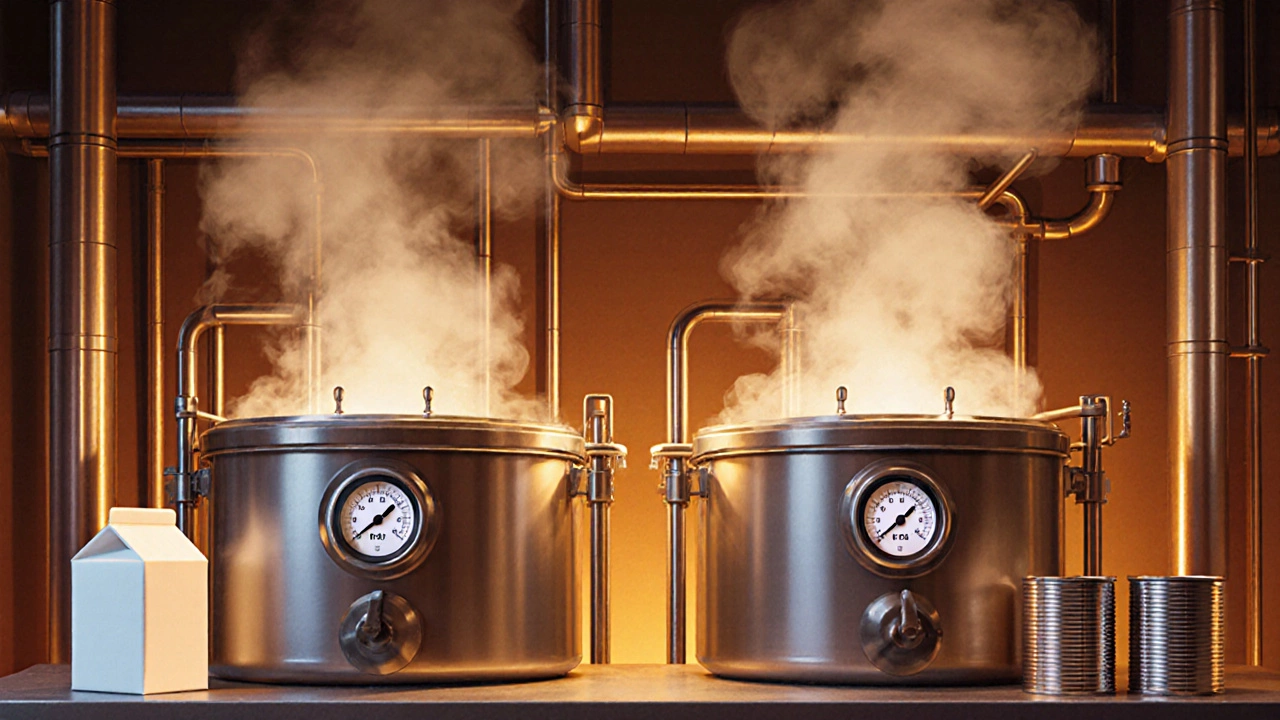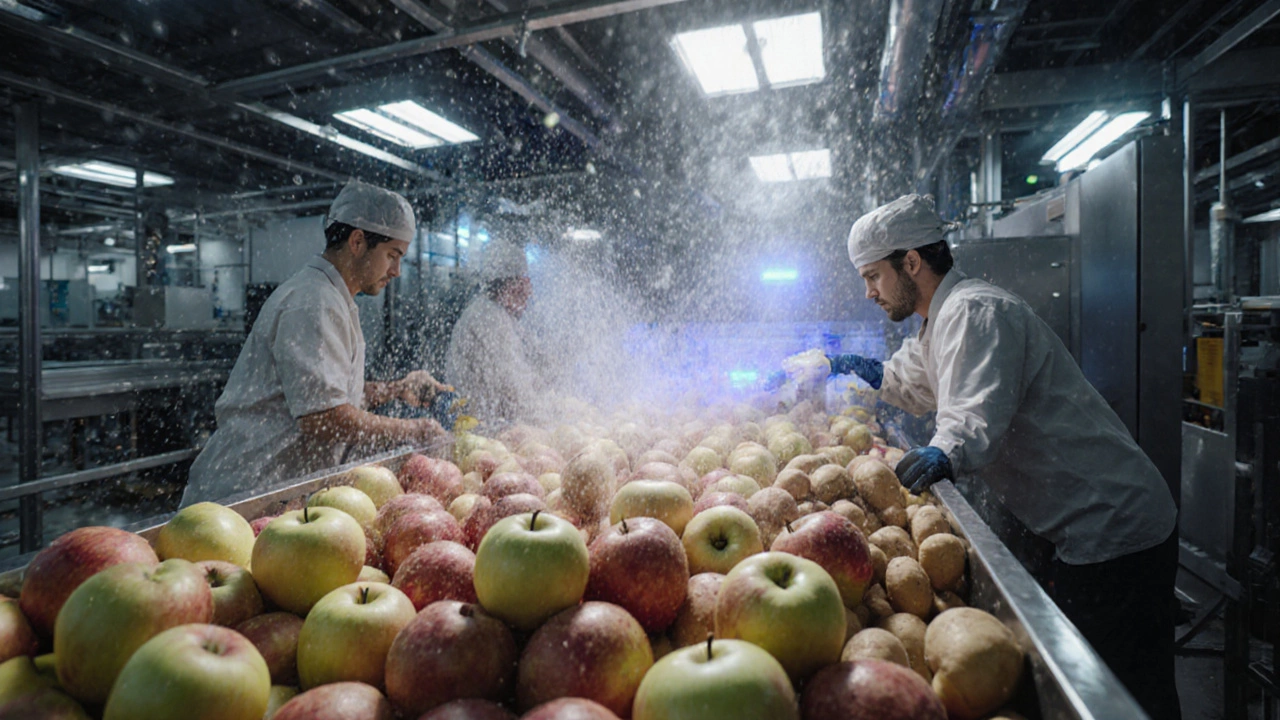Food Preservation Calculator
How Preservation Methods Extend Shelf Life
Food processing uses specific techniques to preserve safety and quality. Each method extends shelf life differently based on the food type and conditions. This calculator shows how different preservation techniques affect shelf life using data from the article.
Enter your details above to see estimated shelf life extension.
Food processing isn’t just about turning raw ingredients into packaged meals. It’s the backbone of what ends up on your plate every day. From the farm to your kitchen, food goes through a series of essential steps that make it safe, shelf-stable, and ready to eat. Without these basic operations, we’d be limited to eating only what’s in season, locally grown, and immediately consumed. That’s not how modern food systems work-and it’s not how they’ve worked for decades.
Cleaning and Sorting
It all starts with cleaning. Raw agricultural products like apples, potatoes, or chicken breasts come out of the field or slaughterhouse covered in dirt, pesticides, feathers, or bacteria. The first job in any food processing unit is to remove those contaminants. This isn’t just washing with water. It involves scrubbing, air blasting, chemical rinses (like chlorine or peracetic acid), and even UV light treatment in high-end facilities.
Sorting follows right after. Machines or workers separate produce by size, color, ripeness, or defects. A single batch of tomatoes might be split into three streams: one for canned tomatoes, one for fresh retail, and one for juice. Poor sorting leads to wasted product or unsafe food. In 2023, the USDA reported that improper sorting contributed to nearly 12% of food recalls in the U.S. alone.
Peeling, Cutting, and Shaping
Once clean and sorted, food gets prepared for its next stage. Peeling removes skins from fruits and vegetables-think potatoes, carrots, or citrus. Modern plants use steam peeling or laser systems for precision. Cutting follows: slicing, dicing, shredding. These aren’t random cuts. They’re standardized to ensure even cooking, consistent texture, and efficient packaging.
Shaping is where food starts to look like the final product. Ground beef becomes patties. Dough gets rolled into bread loaves. Chicken breasts are trimmed and formed into nuggets. These steps rely on molds, extruders, and robotic arms that work with millimeter accuracy. In a plant processing 50,000 chicken nuggets an hour, even a 1% error rate means 500 defective units every hour. That’s why automation here isn’t optional-it’s critical.
Thermal Processing
Heat is one of the oldest and most reliable tools in food processing. It kills pathogens, deactivates enzymes that cause spoilage, and improves digestibility. The two most common methods are pasteurization and sterilization.
Pasteurization heats food-like milk or juice-to around 72°C for 15 seconds. It doesn’t kill everything, but it knocks down harmful bacteria to safe levels. Sterilization goes further: canned foods like beans or soups are heated to 121°C under pressure for 20-40 minutes. That’s enough to destroy even the toughest spores, like those from Clostridium botulinum, which can cause fatal poisoning.
Not all heat treatment is the same. Microwave pasteurization, infrared heating, and ohmic heating are newer techniques that cook food faster and more evenly. These methods reduce nutrient loss and energy use. A 2024 study from the Institute of Food Technologists showed that ohmic heating preserved 20% more vitamin C in orange juice compared to traditional methods.

Preservation Techniques
After heat, food often needs extra protection to last weeks or months. That’s where preservation kicks in. There are five main methods:
- Drying: Removing water to stop microbial growth. Think dried fruits, powdered milk, or instant soup mixes.
- Freezing: Slowing down enzyme activity and bacteria. Most frozen meals are flash-frozen at -40°C within minutes of processing to lock in quality.
- Fermentation: Using good bacteria (like lactobacilli) to preserve food and boost flavor. Yogurt, sauerkraut, and soy sauce are all products of this.
- Chemical preservatives: Adding salt, sugar, vinegar, or synthetic additives like sodium benzoate to inhibit mold and bacteria.
- Modified atmosphere packaging (MAP): Replacing air inside a package with nitrogen or carbon dioxide to slow spoilage. This is why your salad stays crisp for two weeks.
Each method has trade-offs. Freezing preserves nutrients well but needs constant cold storage. Fermentation adds health benefits but requires careful control to avoid spoilage. The right choice depends on the food type, shelf life goals, and consumer expectations.
Mixing and Formulation
Many processed foods aren’t just one ingredient-they’re blends. Breakfast cereals, ready meals, protein bars, and even flavored yogurts are made by combining dozens of components: flour, sugar, oils, vitamins, colors, flavors, stabilizers. Mixing isn’t just stirring. It’s precise formulation.
Food scientists use computer-controlled blenders and dosing systems to add ingredients down to the gram. A single batch of cereal might contain 18 different additives, each with a specific role: some for texture, some for shelf life, some for color. Too much salt? The product fails taste tests. Too little preservative? It molds in two weeks. These formulas are tightly guarded and tested in labs for years before going to market.
Packaging and Labeling
Processing ends with packaging. But packaging isn’t just a container-it’s part of the product’s safety and identity. Materials range from flexible films for snacks to rigid plastic for yogurt cups to glass jars for sauces. Each material is chosen for its barrier properties: how well it blocks oxygen, moisture, or light.
Labeling is legally required and highly regulated. In the U.S., the FDA mandates nutrition facts, ingredient lists, allergen warnings, and expiration dates. In the EU, the rules are even stricter, requiring origin labeling for meat and dairy. Labels also carry marketing messages: “organic,” “non-GMO,” “no added sugar.” These claims are verified by third-party auditors, not just the manufacturer.
Smart packaging is growing fast. Some packages now include time-temperature indicators that change color if the food has been stored too warm. Others have QR codes linking to production records. This isn’t just marketing-it’s traceability. In case of a recall, companies can track every bag of rice back to the exact field it came from.
Quality Control and Testing
At every stage, food is tested. Not just for taste, but for safety. Samples are pulled randomly and sent to labs for microbial testing, chemical residue checks, and physical inspections. Is there E. coli in the ground beef? Are pesticides above legal limits in the apples? Is the sugar content accurate on the label?
Modern plants use sensors that monitor temperature, humidity, and vibration in real time. If a mixer overheats, the system shuts it down automatically. If a conveyor belt slows down, it triggers an alert. This isn’t science fiction-it’s standard in plants that process over 100 tons of food per day.
Failure here has consequences. In 2022, a major U.K. retailer recalled 200,000 meals after a lab found listeria in a batch of pre-cooked chicken. The recall cost over £12 million. That’s why quality control isn’t a department-it’s the entire operation’s heartbeat.
Why These Steps Matter
These basic operations aren’t just technical steps-they’re what make food safe, affordable, and available year-round. They let a family in Manchester eat strawberries in December. They let a single parent buy a frozen meal that feeds three kids for under £5. They let hospitals serve safe meals to patients with weakened immune systems.
Behind every processed food is a chain of precise, controlled operations. Miss one step-say, skipping proper cleaning-and you risk illness. Skip quality control, and you risk a recall. Skip packaging innovation, and you lose shelf life. Every operation has a purpose. Understanding them isn’t just for food scientists or factory workers. It’s for anyone who eats.
What are the five main stages of food processing?
The five main stages are: cleaning and sorting, cutting and shaping, thermal processing (like pasteurization), preservation (drying, freezing, fermentation, etc.), and packaging with labeling. These steps ensure safety, shelf life, and consistency in the final product.
Is all food processing bad for health?
No. Not all food processing is unhealthy. Basic processing like pasteurizing milk, freezing vegetables, or fermenting yogurt improves safety and nutrition. The problem comes with ultra-processed foods-those loaded with added sugars, salt, and artificial additives. These are often made with ingredients you wouldn’t use at home. The key is distinguishing between minimal processing and industrial reformulation.
How do food processors ensure safety?
They use HACCP (Hazard Analysis Critical Control Points), a science-based system that identifies risks at each step and sets strict controls. Every plant must document temperature logs, cleaning schedules, and test results. Inspectors from health agencies visit regularly. Many also use real-time sensors and automated shut-offs to prevent contamination.
What’s the difference between pasteurization and sterilization?
Pasteurization kills most harmful bacteria but doesn’t eliminate all microbes. It’s used for milk, juice, and eggs. Sterilization destroys nearly all microorganisms, including spores. It’s used for canned foods and medical products. Sterilized food can last years without refrigeration; pasteurized food still needs cold storage.
Why is packaging so important in food processing?
Packaging protects food from air, moisture, light, and physical damage. It also prevents contamination and extends shelf life. Modified atmosphere packaging, for example, replaces oxygen with nitrogen to keep snacks crisp. Labels provide legal info and consumer trust. Without proper packaging, even perfectly processed food can spoil before it reaches the store.

